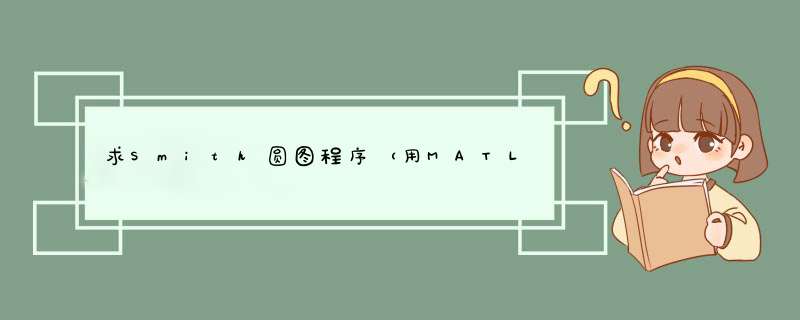
%
%Usage: plotsmithchart(Zl,Zo)
% where Zl is the Load Impedence (possibly complex)
% and Zo is the Characteristic Line Impedence
% Plots a smith chart, along with the reflection coefficient circle
% and the line of intersection with resistive component equal to 1.
% plotsmithchart
% Without any parameters draws a blank smith chart.
% Wavelengths toward the generator are labeled around the perimeter
%
%For example: plotsmithchart(25,50)
% Draws a smithchart, calculates and plots the reflection coefficient
% for a characteristic impedence of 50 ohms and a load impedence of 25 ohms,
% and draws the line of intersection with the R=1 circle.
function answer = plotSmithChart(Zl,Zo)
constant = linspace(0,10,5)
phaseAngle = linspace(0,2*pi,50)
unitGamma = exp(j*phaseAngle)
%plot the unit circle in the complex plane
hold on
plot(real(unitGamma),imag(unitGamma),'r')
%set(gcf,'Position',[0 0 1280 990])
axis square
zoom on
axis([-1.1 1.1 -1.1 1.1])
MAX=2001
bound2=0
bound3=0
min_bound1=0
min_bound2=0
max_bound2=0
H=0
word=0
Gr = linspace(-1,1,MAX)
hold on
interval = [[.01:.01:.2],[.22:.02:.5],[.55:.05:1],[1.1:.1:2],[2.2:.2:5],[6:10],[12:2:20],[30:10:50]]
interval2= [[.01:.01:.5],[.55:.05:1],[1.1:.1:2],[2.2:.2:5],[6:10],[12:2:20],[30:10:50]]
%plot real axis
plot(Gr, zeros(1,length(Gr)),'r')
%equations were derived using the symbolic toolbox as follows
%solve('R=(1-Gr^2-Gi^2)/((1-Gr)^2+Gi^2)','Gi')
%bound was derived as follows
%solve('1/(R+1)*(-(R+1)*(R-2*R*Gr+R.*Gr^2-1+Gr^2))^(1/2)=0','Gr')
for R = interval2,
min_bound1 = (R-1)/(R+1)
if(R<.2)
if(mod(R,.1)==0)
max_bound = (-1+2^2+R^2)/(2^2+R^2+2*R+1)
elseif(mod(R,.02)==0)
max_bound = (-1+.5^2+R^2)/(.5^2+R^2+2*R+1)
else
max_bound = (-1+.2^2+R^2)/(.2^2+R^2+2*R+1)
if(R==.05 | (R<.151 &R>.149))
min_bound2 = (-1+.5^2+R^2)/(.5^2+R^2+2*R+1)
max_bound2 = (-1+1^2+R^2)/(1^2+R^2+2*R+1)
end
end
elseif(R<1)
if(mod(R,.2)==0)
max_bound = (-1+5^2+R^2)/(5^2+R^2+2*R+1)
elseif(mod(R,.1)==0)
max_bound = (-1+2^2+R^2)/(2^2+R^2+2*R+1)
elseif(R==.25 | R==.35 | R==.45)
temp = (-1+.5^2+R^2)/(.5^2+R^2+2*R+1)
min_bound2 = max(min_bound1, temp)
max_bound = (-1+1^2+R^2)/(1^2+R^2+2*R+1)
elseif(R<.5)
max_bound = (-1+.5^2+R^2)/(.5^2+R^2+2*R+1)
else
max_bound = (-1+1^2+R^2)/(1^2+R^2+2*R+1)
end
elseif(R<5)
if(mod(R,2)==0)
max_bound = (-1+20^2+R^2)/(20^2+R^2+2*R+1)
elseif(mod(R,1)==0)
max_bound = (-1+10^2+R^2)/(10^2+R^2+2*R+1)
elseif(R>2)
max_bound = (-1+5^2+R^2)/(5^2+R^2+2*R+1)
else
if(mod(R,.2)==0)
max_bound = (-1+5^2+R^2)/(5^2+R^2+2*R+1)
else
max_bound = (-1+2^2+R^2)/(2^2+R^2+2*R+1)
end
end
elseif(R<10)
if(mod(R,2)==0)
max_bound = (-1+20^2+R^2)/(20^2+R^2+2*R+1)
else
max_bound = (-1+10^2+R^2)/(10^2+R^2+2*R+1)
end
else
if(R==10|R==20)
max_bound = (-1+50^2+R^2)/(50^2+R^2+2*R+1)
elseif(R==50)
max_bound = 1
elseif(R<20)
max_bound = (-1+20^2+R^2)/(20^2+R^2+2*R+1)
else
max_bound = (-1+50^2+R^2)/(50^2+R^2+2*R+1)
end
end
index = ceil((min_bound1+1)*(MAX-1)/2+1)
actual_value = Gr(index)
if(actual_value<min_bound1)
index = index + 1
end
MIN=index
index = ceil((max_bound+1)*(MAX-1)/2+1)
actual_value = Gr(index)
if(actual_value>max_bound)
index = index - 1
end
MIN2 = ceil((min_bound2+1)*(MAX-1)/2+1)
actual_value = Gr(MIN2)
if(actual_value<min_bound2 )
MIN2 = MIN2 + 1
end
MAX2 = ceil((max_bound2+1)*(MAX-1)/2+1)
actual_value = Gr(MAX2)
if(actual_value<max_bound2 )
MAX2 = MAX2 + 1
end
r_L_a=1/(R+1)*(-(R+1)*(R-2*R.*Gr(MIN:index)+R.*Gr(MIN:index).^2-1+Gr(MIN:index).^2)).^(1/2)
r_L_b=-1/(R+1)*(-(R+1)*(R-2*R.*Gr(MIN:index)+R.*Gr(MIN:index).^2-1+Gr(MIN:index).^2)).^(1/2)
r_L_b(1)=0
r_L_a(1)=0
r_L_a2=1/(R+1)*(-(R+1)*(R-2*R.*Gr(MIN2:MAX2)+R.*Gr(MIN2:MAX2).^2-1+Gr(MIN2:MAX2).^2)).^(1/2)
r_L_b2=-1/(R+1)*(-(R+1)*(R-2*R.*Gr(MIN2:MAX2)+R.*Gr(MIN2:MAX2).^2-1+Gr(MIN2:MAX2).^2)).^(1/2)
r_L_a3=1/(R+1)*(-(R+1)*(R-2*R.*Gr(MIN2:index)+R.*Gr(MIN2:index).^2-1+Gr(MIN2:index).^2)).^(1/2)
r_L_b3=-1/(R+1)*(-(R+1)*(R-2*R.*Gr(MIN2:index)+R.*Gr(MIN2:index).^2-1+Gr(MIN2:index).^2)).^(1/2)
%fix resolution issues in .2-.5 range
if(~(R>.2 &R<.5 &~(mod(R,.02)==0)))
if(R==1)
color = 'r'
else
color ='b'
end
plot(Gr(MIN:index),r_L_a(1:index-MIN+1),color,Gr(MIN:index), r_L_b(1:index-MIN+1),color)
if(R<=1)
if(mod(R,1)==0)
word = [num2str(R) '.0']
else
word = num2str(R)
end
if(mod(R,.1)==0)
set(text(Gr(MIN),0,word),'Rotation',90,'HorizontalAlignment','left','VerticalAlignment','bottom')
end
elseif(R<=2)
if(mod(R,.2)==0)
if(mod(R,1)==0)
word = [num2str(R) '.0']
else
word = num2str(R)
end
set(text(Gr(MIN),0,word),'Rotation',90,'HorizontalAlignment','left','VerticalAlignment','bottom')
end
elseif(R<=5)
if(mod(R,1)==0)
set(text(Gr(MIN),0,[num2str(R) '.0']),'Rotation',90,'HorizontalAlignment','left','VerticalAlignment','bottom')
end
else
if(mod(R,10)==0)
set(text(Gr(MIN),0,num2str(R)),'Rotation',90,'HorizontalAlignment','left','VerticalAlignment','bottom')
end
end
elseif(R==.25 | R==.35 | R==.45)
plot(Gr(MIN2:index),r_L_a3,'b')
plot(Gr(MIN2:index),r_L_b3,'b')
end
if(R==.05 | (R>.149 &R<.151))
plot(Gr(MIN2:MAX2),r_L_a2(length(Gr(MIN2:MAX2))-length(r_L_a2)+1:length(r_L_a2)),'b')
plot(Gr(MIN2:MAX2),r_L_b2(length(Gr(MIN2:MAX2))-length(r_L_b2)+1:length(r_L_b2)),'b')
end
end
%equations were derived using the symbolic toolbox as follows
%solve('2*Gi/((1-Gr)^2+Gi^2)=x','Gi')
%bound was derived as follows
%solve('1-X^2+2*X^2*Gr-X^2*Gr^2=0','Gr')
%solve('1/2/X*(2+2*(1-X^2+2*X^2*Gr-X^2*Gr^2)^(1/2))=(1-Gr^2)^(1/2)','Gr')
for X = interval,
inter_bound = (-1+X^2)/(X^2+1)%intersection with unit circle: all values must be less than this\
imag_bound = (-1+X)/X%boundary of imagination: all values must be greater than this
angle_point = 0
if(inter_bound ~= 0)
angle_point = sqrt(1-inter_bound^2)/inter_bound
end
imag_bound_y = 1/2/X*(-2+2*(1-X^2+2*X^2.*inter_bound-X^2.*inter_bound.^2).^(1/2))
imag_rad = (imag_bound^2 + imag_bound_y^2)^(1/2)
condition = imag_rad <1
if(inter_bound >1)
inter_bound = 1
elseif(inter_bound <-1)
imag_bound=-1
end
if(imag_bound >1)
imag_bound = 1
elseif(imag_bound <-1)
imag_bound=-1
end
%used solve function to find intersection of appropriate circle with corresponding hyperbolics
%solve('-1/(R+1)*(-(R+1)*(R-2*R*Gr+R*Gr^2-1+Gr^2))^(1/2)=1/2/X*(-2+2*(1-X^2+2*X^2*Gr-X^2*Gr^2)^(1/2))','Gr')
%The following conditional tree creates the internal bounding between the two types of curves for variable resolution
if(X<.2)
if(mod(X,.1)==0)
max_bound = (-1+X^2+2^2)/(X^2+2^2+2*2+1)
elseif(mod(X,.02)==0)
max_bound = (-1+X^2+.5^2)/(X^2+.5^2+2*.5+1)
else
max_bound = (-1+X^2+.2^2)/(X^2+.2^2+2*.2+1)
end
elseif(X<1)
if(mod(X,.2)==0)
max_bound = (-1+X^2+5^2)/(X^2+5^2+2*5+1)
elseif(mod(X,.1)==0)
max_bound = (-1+X^2+2^2)/(X^2+2^2+2*2+1)
elseif(X<.5)
max_bound = (-1+X^2+.5^2)/(X^2+.5^2+2*.5+1)
else
max_bound = (-1+X^2+1^2)/(X^2+1^2+2*1+1)
end
elseif(X<5)
if(mod(X,2)==0)
max_bound = (-1+X^2+20^2)/(X^2+20^2+2*20+1)
elseif(mod(X,1)==0)
max_bound = (-1+X^2+10^2)/(X^2+10^2+2*10+1)
elseif(X>2)
max_bound = (-1+X^2+5^2)/(X^2+5^2+2*5+1)
else
if(mod(X,.2)==0)
max_bound = (-1+X^2+5^2)/(X^2+5^2+2*5+1)
else
max_bound = (-1+X^2+2^2)/(X^2+2^2+2*2+1)
end
end
elseif(X<10)
if(mod(X,2)==0)
max_bound = (-1+X^2+20^2)/(X^2+20^2+2*20+1)
else
max_bound = (-1+X^2+10^2)/(X^2+10^2+2*10+1)
end
else
if(X==10|X==20)
max_bound = (-1+X^2+50^2)/(X^2+50^2+2*50+1)
elseif(X==50)
max_bound = 1
elseif(X<20)
max_bound = (-1+X^2+20^2)/(X^2+20^2+2*20+1)
else
max_bound = (-1+X^2+50^2)/(X^2+50^2+2*50+1)
end
end
inter_index = ceil((inter_bound+1)*(MAX-1)/2+1)
imag_index = ceil((imag_bound+1)*(MAX-1)/2+1)
index4 = ceil((max_bound+1)*(MAX-1)/2+1)
index1 = max(inter_index,imag_index)%maximum index for c,d
index2 = min(imag_index,inter_index)%minimum index for c,d
if(condition)
index3=imag_index
else
index3=inter_index
end
actual_value1 = Gr(index1)
actual_value2 = Gr(index2)
actual_value3 = Gr(index3)
actual_value4 = Gr(index4)
if((actual_value1 >inter_bound &index1 == inter_index)|(actual_value1 >imag_bound &index1 == imag_index))
index1 = index1 - 1
end
if((actual_value2 <inter_bound &index2 == inter_index)|(actual_value2 <imag_bound &index2 == imag_index))
index2 = index2 + 1
end
if((actual_value3 <inter_bound &index3 == inter_index)|(actual_value3 <imag_bound &index3 == imag_index))
index3 = index3 + 1
end
if(actual_value4 >max_bound)
index4 = index4 - 1
end
MIN=index2
MAX2=index1
MAX3=index4
MIN2 = index3
% actual_value1 = Gr(MIN)
% actual_value2 = Gr(MAX2)
% MIN=1
% MAX2=MAX
% MIN2=1
x_L_a = real(1/2/X*(-2+2*(1-X^2+2*X^2.*Gr(MIN2:MAX3)-X^2.*Gr(MIN2:MAX3).^2).^(1/2)))
x_L_b = real(1/2/X*(2-2*(1-X^2+2*X^2.*Gr(MIN2:MAX3)-X^2.*Gr(MIN2:MAX3).^2).^(1/2)))
x_L_c= real(1/2/X*(2+2*(1-X^2+2*X^2.*Gr(MIN:MAX2)-X^2.*Gr(MIN:MAX2).^2).^(1/2)))
x_L_d= real(1/2/X*(-2-2*(1-X^2+2*X^2.*Gr(MIN:MAX2)-X^2.*Gr(MIN:MAX2).^2).^(1/2)))
if(MIN2<MAX3)
x_L_c(1)=x_L_b(1)
x_L_d(1)=x_L_a(1)
end
check1 = abs(round(10000*1/2/X*(-2-2*(1-X^2+2*X^2*inter_bound-X^2*inter_bound^2)^(1/2))))
check2 = abs(round(10000*(1-inter_bound^2)^(1/2)))
if(imag_bound >-1 &check1 == check2)
plot(Gr(MIN:MAX2),x_L_c,'g')
plot(Gr(MIN:MAX2),x_L_d,'g')
end
plot(Gr(MIN2:MAX3),x_L_a,'g')
plot(Gr(MIN2:MAX3),x_L_b,'g')
condition = Gr(MIN2)^2 + x_L_d(1)^2 >.985
if(X<=1)
if(mod(X,.1)==0)
if(mod(X,1)==0)
word = [num2str(X) '.0']
else
word = num2str(X)
end
if(X==1)
angle = 90
else
angle = -atan(angle_point)*180/pi
end
set(text(Gr(MIN2),x_L_d(1),word),'Rotation',angle,'VerticalAlignment','bottom','HorizontalAlignment','left')
set(text(Gr(MIN2),-x_L_d(1),word),'Rotation',-angle+180,'HorizontalAlignment','right','VerticalAlignment','bottom')
if(mod(X,.2)==0)
xval=X^2/(X^2+4)
yval = 1/2/X*(-2+2*(1-X^2+2*X^2*xval-X^2*xval^2)^(1/2))
angle = -atan(yval/(.5-xval))*180/pi
set(text(xval,yval,word),'Rotation',angle,'HorizontalAlignment','left','VerticalAlignment','bottom')
set(text(xval,-yval,word),'Rotation',-angle+180,'HorizontalAlignment','right','VerticalAlignment','bottom')
end
end
elseif(X<=2)
if(mod(X,.2)==0)
if(mod(X,1)==0)
word = [num2str(X) '.0']
else
word = num2str(X)
end
if(condition)
angle = -atan(angle_point)*180/pi+180
set(text(Gr(MIN2),x_L_a(1),word),'Rotation',angle,'VerticalAlignment','bottom','HorizontalAlignment','left')
set(text(Gr(MIN2),-x_L_a(1),word),'Rotation',-angle+180,'HorizontalAlignment','right','VerticalAlignment','bottom')
else
angle = -atan(angle_point)*180/pi+180
set(text(Gr(MAX2),x_L_d(length(x_L_d)),word),'Rotation',angle,'VerticalAlignment','bottom','HorizontalAlignment','left')
set(text(Gr(MAX2),-x_L_d(length(x_L_d)),word),'Rotation',-angle+180,'HorizontalAlignment','right','VerticalAlignment','bottom')
end
end
elseif(X<=5)
if(mod(X,1)==0)
if(condition)
angle = -atan(angle_point)*180/pi+180
set(text(Gr(MIN2),x_L_a(1),[num2str(X) '.0']),'Rotation',angle,'VerticalAlignment','bottom','HorizontalAlignment','left')
set(text(Gr(MIN2),-x_L_a(1),[num2str(X) '.0']),'Rotation',-angle+180,'HorizontalAlignment','right','VerticalAlignment','bottom')
else
angle = -atan(angle_point)*180/pi+180
set(text(Gr(MAX2),x_L_d(length(x_L_d)),[num2str(X) '.0']),'Rotation',angle,'VerticalAlignment','bottom','HorizontalAlignment','left')
set(text(Gr(MAX2),-x_L_d(length(x_L_d)),[num2str(X) '.0']),'Rotation',-angle+180,'HorizontalAlignment','right','VerticalAlignment','bottom')
end
end
else
if(mod(X,10)==0)
if(condition)
angle = -atan(angle_point)*180/pi+180
set(text(Gr(MIN2),x_L_a(1),num2str(X)),'Rotation',angle,'VerticalAlignment','bottom','HorizontalAlignment','left')
set(text(Gr(MIN2),-x_L_a(1),num2str(X)),'Rotation',-angle+180,'HorizontalAlignment','right','VerticalAlignment','bottom')
else
angle = -atan(angle_point)*180/pi+180
set(text(Gr(MAX2),x_L_d(length(x_L_d)),num2str(X)),'Rotation',angle,'VerticalAlignment','bottom','HorizontalAlignment','left')
set(text(Gr(MAX2),-x_L_d(length(x_L_d)),num2str(X)),'Rotation',-angle+180,'HorizontalAlignment','right','VerticalAlignment','bottom')
end
end
end
end
%plot imaginary axis
plot(zeros(1,length(Gr)),Gr,'r')
wavelengths = 0:.01:.5
angle = linspace(pi,-pi,length(wavelengths))
wave_circle = 1.05*exp(j*phaseAngle)
plot(real(wave_circle),imag(wave_circle),'r')
for i=1:length(wavelengths)-1,
x=real(1.025*exp(j*angle(i)))
y=imag(1.025*exp(j*angle(i)))
if(x>0)
rot_angle=atan(y/x)*180/pi-90
else
rot_angle=atan(y/x)*180/pi+90
end
if(wavelengths(i)==0)
word = '0.00'
elseif(mod(wavelengths(i),.1)==0)
word = [num2str(wavelengths(i)) '0']
else
word = num2str(wavelengths(i))
end
set(text(x,y,word),'Rotation',rot_angle,'VerticalAlignment','middle','HorizontalAlignment','center')
end
%plot reflection coefficient and line of intersection only if arguments are present
if(nargin == 2)
radius = abs((Zl-Zo)/(Zl+Zo))
Load_circle=radius*exp(j*phaseAngle)
plot(real(Load_circle),imag(Load_circle),'r')
slope = (-(1-radius^2)^(1/2)*radius)/(radius^2)
value=1/(1+slope^2)^(1/2)
MAX2 = ceil((value+1)*(MAX-1)/2+1)
actual_value = Gr(MAX2)
if(actual_value>value)
MAX2 = MAX2 - 1
end
%plot line of intersection
line = slope*Gr(fix(MAX/2):MAX2)
plot(Gr(fix(MAX/2):MAX2),line,'r')
end
史密夫图表又称史密斯圆图是在反射系散平面上标绘有归一化输入阻抗(或导纳)等值圆族的计算图。
用ADS来举例,在元件库下拉栏里选择simulation-S-param库,调出来端口term,S参数仿真控件,再在smithchartmatching里把smith圆图放在两个端口中间连起来,端口记得接地,这个元件库在一堆passive的下面一个,把左面端口设置成你想要的阻抗共轭值,比如,你管子的输出阻抗是50Ω+100Ω,你就把端口设成Z=50-j*100,然后点在那个圆图标志上,单击选中,在tools里选择Smithchart,点那个Z*,设置成Z的共轭,也就是你管子输出阻抗,左面是各种串并联阻抗的形式,这个你看看就会了,记得要改你的频率,还有S参数SP1的频率也是,看你需求了,最后你应该是用一堆元件,把圆图中心的点和你想要的那个Z*连起来,在匹配的时候把circles里的Q打开,设置成1.5,你的匹配线不要超出这个范围。大概就是这样吧,具体还有要涉及到版图里微带线的问题,还是要看下书。
【原理】
通过控制角度来控制你需要的范围。
【代码】
r0=1
theta0=linspace(0*pi/2,4*pi/2,1000)
x0=(0+1j*0)
c0=r0*exp(1j*theta0)-x0
r1=1
theta1=linspace(2*pi/2,3*pi/2,1000)
x1=(1+1j*1)
c1=r1*exp(1j*theta1)+x1
plot(real(c0),imag(c0))hold on
plot(real(c1),imag(c1))hold off
grid on
xlim([-2 2])ylim([-2 2])
【结果】
欢迎分享,转载请注明来源:内存溢出

 微信扫一扫
微信扫一扫
 支付宝扫一扫
支付宝扫一扫
评论列表(0条)